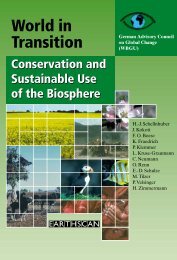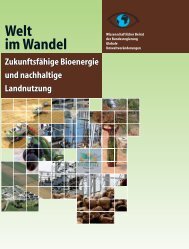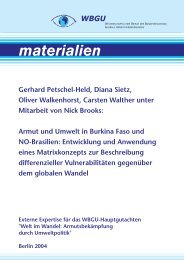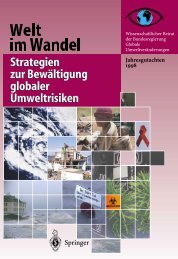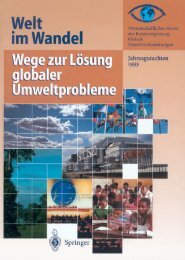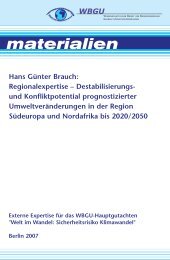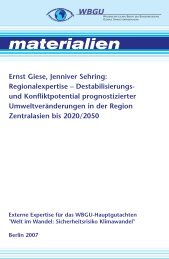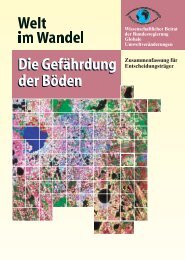World in Transition: Climate Change as a Security Risk - WBGU
World in Transition: Climate Change as a Security Risk - WBGU
World in Transition: Climate Change as a Security Risk - WBGU
You also want an ePaper? Increase the reach of your titles
YUMPU automatically turns print PDFs into web optimized ePapers that Google loves.
160<br />
8 <strong>Climate</strong> change <strong>as</strong> a driver of social destabilization and threat to <strong>in</strong>ternational security<br />
'Food'<br />
conflict constellation<br />
'Freshwater'<br />
conflict constellation<br />
<strong>Climate</strong> change<br />
Destabilization<br />
of societies<br />
Instability and <strong>in</strong>security<br />
<strong>in</strong> the <strong>in</strong>ternational system<br />
erty reduction. 70 per cent of freshwater is used for<br />
farm<strong>in</strong>g. Unfavourable climate-related changes <strong>in</strong><br />
water availability, for <strong>in</strong>stance <strong>as</strong> a result of glacier<br />
melt or greater variability of precipitation, can have<br />
severe impacts upon the conditions for agricultural<br />
production and thus upon the livelihoods of rural<br />
populations. Such trends are amplified by competition<br />
with other forms of resource use, e.g. hydropower<br />
and bioenergy, and by pre-exist<strong>in</strong>g environmental<br />
problems such <strong>as</strong> soil degradation. Where the<br />
key political and <strong>in</strong>stitutional preconditions for function<strong>in</strong>g<br />
water resources management are absent and<br />
water crises emerge, food crises can be triggered or<br />
worsened. Conversely, non-susta<strong>in</strong>able agricultural<br />
practices can play a part <strong>in</strong> caus<strong>in</strong>g water stress and<br />
conflict by overexploit<strong>in</strong>g water resources, or contam<strong>in</strong>at<strong>in</strong>g<br />
them with fertilizers and pesticides and<br />
thus render<strong>in</strong>g them unusable. Pre-exist<strong>in</strong>g soil degradation,<br />
water scarcity, non-susta<strong>in</strong>able utilization<br />
methods (e.g. expansion of unsusta<strong>in</strong>able irrigation<br />
farm<strong>in</strong>g) and resource competition (e.g. due to the<br />
construction of dams) <strong>in</strong> comb<strong>in</strong>ation with poverty,<br />
weak <strong>in</strong>stitutions and political <strong>in</strong>stability can thus<br />
concentrate and amplify impacts regionally, thereby<br />
overwhelm<strong>in</strong>g <strong>in</strong>stitutions and caus<strong>in</strong>g crises to escalate.<br />
F<strong>in</strong>ally, <strong>in</strong> extreme c<strong>as</strong>es, drought or water stress<br />
will force people to leave their homelands because<br />
they can no longer cultivate the land and have no<br />
alternative way of mak<strong>in</strong>g a liv<strong>in</strong>g. They might also<br />
flee war and violence once ecological problems have<br />
<strong>in</strong>duced a social crisis. Migration can then, <strong>in</strong> turn,<br />
become the cause of various types of conflicts <strong>in</strong> the<br />
transit and dest<strong>in</strong>ation regions. A growth <strong>in</strong> population<br />
and thus <strong>in</strong> demand could, for <strong>in</strong>stance, over-<br />
'Storm and flood'<br />
conflict constellation<br />
'Migration'<br />
conflict constellation<br />
Figure 8.1-1<br />
Conflict constellations <strong>as</strong><br />
drivers of <strong>in</strong>ternational<br />
destabilization.<br />
Source: <strong>WBGU</strong><br />
whelm local water management or lead to further<br />
demographic pressure, e.g. <strong>in</strong> co<strong>as</strong>tal conurbations<br />
at risk of storm surges. Through these mechanisms,<br />
poor or absent migration management can adversely<br />
affect water availability and food production <strong>as</strong> well<br />
<strong>as</strong> dis<strong>as</strong>ter risk management structures <strong>in</strong> the transit<br />
and dest<strong>in</strong>ation regions.<br />
It can be expected that climate change impacts<br />
will lead to a considerable <strong>in</strong>cre<strong>as</strong>e <strong>in</strong> the number<br />
of migrants. These migration movements will occur<br />
ma<strong>in</strong>ly between develop<strong>in</strong>g countries, but the developed<br />
world will also be a target dest<strong>in</strong>ation of environmental<br />
migrants. An <strong>in</strong>cre<strong>as</strong>e of the <strong>as</strong>sociated<br />
conflicts is therefore likely. Here, too, there are signs<br />
of self-re<strong>in</strong>forc<strong>in</strong>g feedback among the conflict constellations,<br />
and their concentration <strong>in</strong> the develop<strong>in</strong>g<br />
world.<br />
The <strong>in</strong>teractions described here can already be<br />
observed today. In future they will occur more frequently<br />
and <strong>in</strong> new regions. For <strong>in</strong>stance, the population<br />
of the Sahel zone already suffers drought and<br />
hunger today. Further contraction of farmland due to<br />
drought and water shortage and an expansion of the<br />
drought zones towards the North <strong>in</strong>to the Mediterranean<br />
region and towards E<strong>as</strong>t and West Africa will<br />
amplify the potential for crisis and the probability of<br />
migration (Fig. 8.1-2). North-western Brazil is also<br />
at risk of becom<strong>in</strong>g a new drought-prone area. The<br />
Andes and Himalayan regions will be particularly<br />
exposed to the problem of glacier melt and resultant<br />
water shortage <strong>in</strong> the dry months (IPCC, 2007b).





